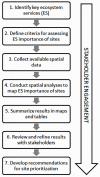Rapid Assessment of Ecosystem Service Co-Benefits of Biodiversity Priority Areas in Madagascar
- PMID: 28006005
- PMCID: PMC5179119
- DOI: 10.1371/journal.pone.0168575
Rapid Assessment of Ecosystem Service Co-Benefits of Biodiversity Priority Areas in Madagascar
Abstract
The importance of ecosystems for supporting human well-being is increasingly recognized by both the conservation and development sectors. Our ability to conserve ecosystems that people rely on is often limited by a lack of spatially explicit data on the location and distribution of ecosystem services (ES), the benefits provided by nature to people. Thus there is a need to map ES to guide conservation investments, to ensure these co-benefits are maintained. To target conservation investments most effectively, ES assessments must be rigorous enough to support conservation planning, rapid enough to respond to decision-making timelines, and often must rely on existing data. We developed a framework for rapid spatial assessment of ES that relies on expert and stakeholder consultation, available data, and spatial analyses in order to rapidly identify sites providing multiple benefits. We applied the framework in Madagascar, a country with globally significant biodiversity and a high level of human dependence on ecosystems. Our objective was to identify the ES co-benefits of biodiversity priority areas in order to guide the investment strategy of a global conservation fund. We assessed key provisioning (fisheries, hunting and non-timber forest products, and water for domestic use, agriculture, and hydropower), regulating (climate mitigation, flood risk reduction and coastal protection), and cultural (nature tourism) ES. We also conducted multi-criteria analyses to identify sites providing multiple benefits. While our approach has limitations, including the reliance on proximity-based indicators for several ES, the results were useful for targeting conservation investments by the Critical Ecosystem Partnership Fund (CEPF). Because our approach relies on available data, standardized methods for linking ES provision to ES use, and expert validation, it has the potential to quickly guide conservation planning and investment decisions in other data-poor regions.
Conflict of interest statement
The authors have declared that no competing interests exist.
Figures








References
-
- Millennium Ecosystem Assessment. Ecosystems and Human Well-being: Synthesis [Internet]. Washington, DC: Island Press; 2005. http://www.millenniumassessment.org/documents/document.356.aspx.pdf
-
- Costanza R, de Groot R, Sutton P, van der Ploeg S, Anderson SJ, Kubiszewski I, et al. Changes in the global value of ecosystem services. Global Environmental Change. 2014. May;26:152–8.
-
- Maes J, Egoh B, Willemen L, Liquete C, Vihervaara P, Schägner JP, et al. Mapping ecosystem services for policy support and decision making in the European Union. Ecosystem Services. 2012. July;1(1):31–9.
-
- TEEB. The Economics of Ecosystems and Biodiversity: Ecological and Economic Foundations [Internet]. Routledge; 2010. 455 p. http://www.teebweb.org/our-publications/teeb-study-reports/ecological-an...
-
- United Nations General Assembly. Draft outcome document of the United Nations summit for the adoption of the post-2015 development agenda [Internet]. United Nations General Assembly; 2015 Aug. Report No.: A/69/L.85. Available from: http://www.un.org/ga/search/view_doc.asp?symbol=A/69/L.85&Lang=E
MeSH terms
LinkOut - more resources
Full Text Sources
Other Literature Sources

